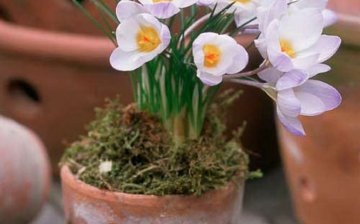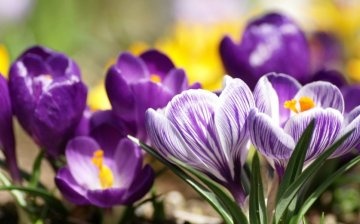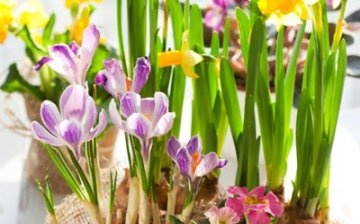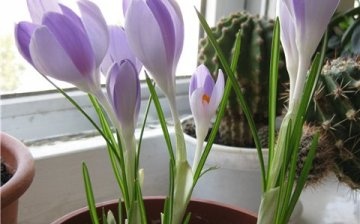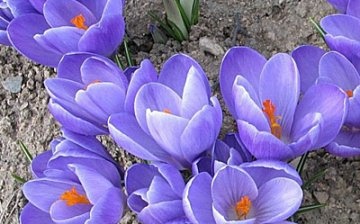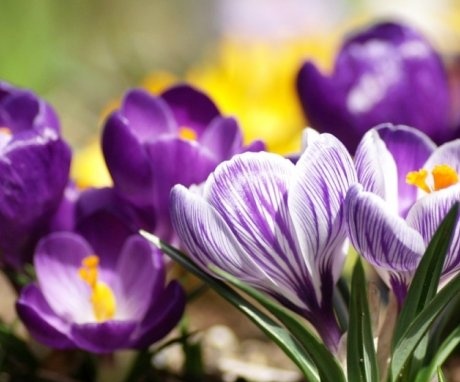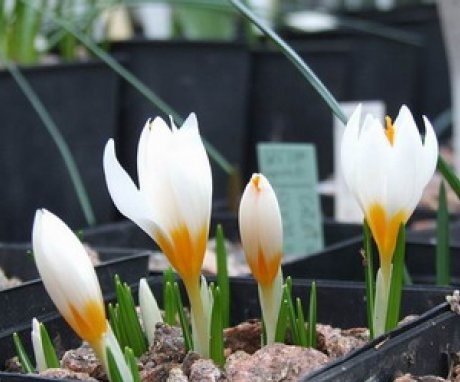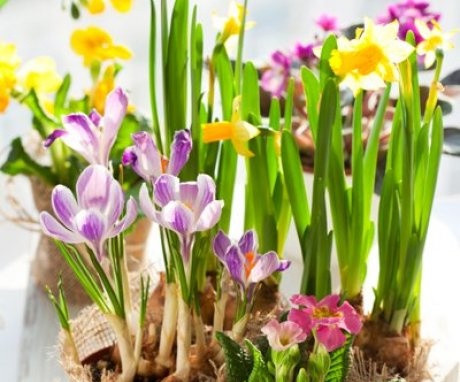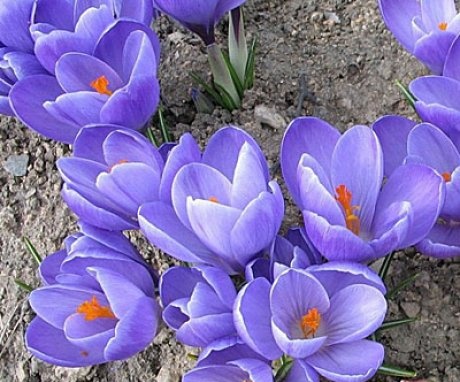Indoor crocus: home care and growing secrets
Crocus is a delicate primrose that has attracted flower lovers for centuries with the beauty of its buds. It is this flower that is one of the first to welcome the coming spring, and it is quite possible to grow it on the windowsill. If you plant a crocus, home care does not require much effort, and very soon it will delight the owners with magnificent flowering. This is one of the simplest and at the same time charming indoor plants.
Content:
- Appearance and flowering period
- Growth and flowering conditions
- Forcing crocuses at home
- Secrets of forcing crocuses on the windowsill
- Reproduction and selection of crocus varieties
Appearance and flowering period
Crocus has been cultivated for many hundreds of years, it is widely distributed in natural conditions in the Mediterranean countries, in Eastern Europe, it is also found in Central Asia. It is known that this flower was highly valued by the Egyptian pharaohs.
Crocus is a perennial bulbous plant, it belongs to the botanical family of iris, which has several dozen genera.
There are more than 100 types of crocus, and some of them do not bloom in spring, but in autumn. If you plant two types of crocuses in a room, they will be the first to greet spring and become the last symbol of the outgoing summer. They are grown both in the garden and at home.
Crocus features:
- The height of the crocus stem can reach 25 cm, several scales are located at the root, which make the plant somewhat similar to a tulip during the flowering period. The flower is goblet, it has six petals, which can have very different colors.
- Any crocus variety has yellow or orange stamens, this is one of the distinguishing features of the plant.
- Flowers can be either one-color or two-color: white-blue, bluish-lilac, etc.
- Blooming crocuses can be a real treat: bright buds adorn any room, and you can guess the flowering period by a certain date: for example, you can achieve that the bud is fully bloomed by March 8 or by Christmas.
Growth and flowering conditions
Crocuses have a short growing season, like many other types of bulbous plants.
In the spring they begin to grow actively, and by the middle of summer the leaves completely dry up and fall off. The aerial part of the plant should completely die off, the bulb then goes into a dormant phase, it should recuperate for the next flowering period. To provide crocuses with fast growth, they need to create conditions that will be as close to natural as possible.
Basic principles of growing at home:
- These are light-loving plants that prefer well-lit places. When choosing a place for crocuses, you should prefer the south side of the house: this will provide the plants with sunlight. If they grow in the shade, the buds will not fully open.
- The second important condition is necessarily drained soil. If moisture stagnates in the soil, the bulb will begin to rot very soon.Coarse river sand can be used as drainage; gravel is also suitable.
- Watering should be moderate but regular. During the entire dormant period, the bulb should be in a dry environment, it is not necessary to spray it.
- Indoor crocuses do not like acidic soil; it is best to choose loams that will not retain moisture. Depleted soils are diluted with rotted manure mixed with lime; leafy soil can also be used.
- When replanting, it is necessary to use only fresh soil, it can consist of sod and leafy soil, as well as clean sand. When transplanting, you can add a small amount of mineral dressing, which includes potassium and phosphates.
- The normal temperature in the room is 18-20 degrees; in winter, the bulbs should be kept in a cool room at a temperature not exceeding 10 degrees.
Forcing crocuses at home
For storage and subsequent disembarkation, you must choose the densest bulbshaving a large mass. All their shells must be intact; there must be no softened areas on the bulb, indicating the beginning of rotting. They are transplanted into the ground about three months before the desired flowering time. For example, if you need to get flowers for the New Year, the bulbs are planted in the ground around mid-September.
The bulbs can be stored only after two weeks of airing to prevent the development of rotting.
Planting and transplanting a crocus:
- For planting, choose shallow and wide pots, and if several bulbs are planted in one container, they should not come into contact with each other, as well as with the walls of the pots.
- Often, first a thick sandy layer is placed in the pots, and a layer of soil on top. This will provide both root nutrition and good drainage.
- The tip of the bulb is sometimes left on the surface, but more often it is completely buried in the ground.
- After planting, the pots of bulbs are placed in a dark room for about 2 months.
- During this period, the bulbs give roots, they should take root well. After that, the first green shoots will appear.
- When their height is 3-5 cm, the plants are brought out into the light, they should grow at a temperature of 10 to 15 degrees.
- It is important that the temperature is not higher: in this case, the crocuses will grow very quickly and they will fade in the shortest possible time.
If the plant lacks light, it will not be able to produce a large bud.
Water the bulbs sparingly.: Crocuses are classified as drought-resistant bulbous plants, so they can easily tolerate drying of the topsoil. Watering continues until the leaves of the plant completely fall off. Watering regularly after flowering will allow the bulb to absorb enough moisture and nutrients for the rest of the dormant period.
Secrets of forcing crocuses on the windowsill
In general, crocus care is quite simple, but if you know certain subtleties and nuances, you can not only get abundant flowering, but also achieve the appearance of buds by a certain date.
Several cultivation features used by experienced florists:
- It is necessary choose the right crocus variety... There are more than a hundred of them in total: there are early and late varieties that you need to consider if you want to get beautiful buds by a certain time. In addition, there are large-flowered and small-flowered varieties: it is better to give preference to the first of them. Small-flowered crocuses do not look so impressive.
- Crocuses of several varieties cannot be planted in one common container: they will have different stem heights, in addition, due to different flowering periods, it is impossible to accurately comply with the forcing conditions. As a result, the pot will be exposed to the sun, when the root system of the later varieties is not yet sufficiently formed. As a result, plants will not be able to produce large buds.
- It is advisable to plant bulbs of about the same size in a container. Small bulbs bloom later, so it will not be possible to achieve uniform, friendly flowering.
- Exposure of plants in the first period after planting in the ground should be carried out in a cold room. An attic, a cellar will do; in an apartment, bulbs can be placed on a loggia if you create an artificial darkening.
- Before bringing crocuses into the light, you need to feel the emerging sprout: it should be as dense to the touch, this indicates that the plant is already ready for distillation. If the sprout seems loose, the time for the light phase has not yet come.
Crocus pots should also be kept in a cool place during flowering, such as near a window or balcony frame.
Experienced flower growers know another secret to prolong flowering: during this period, plants need to be cleaned in the cold at night: if the night temperature is only about 3 degrees, the flowering duration can be significantly increased. Overheating the plant has the opposite effect: if the temperature is above 20 degrees, the crocus can fade in a few hours.
Reproduction and selection of crocus varieties
Crocuses reproduce most often by daughter bulbs, planting material for purchase is chosen at the very end of summer or early autumn. Each onion produces several babies each year, which can be used for subsequent distillation.
In some cases, seed propagation is used, but it is rarely used.
Most often, seeds are used for breeding work: such reproduction will allow you to get buds of unusual colors, which can decorate both the windowsill and flower beds. However, if you use exactly the seeds, you can get the first flowering no earlier than after 3 years.
Most often, large-flowered Dutch hybrids are chosen for home cultivation, which are distinguished by their hardiness and very beautiful flowering. Such varieties reproduce by bulbous babies, you can buy them at any specialty store.
Several common unit vectors:
- Blue Vangart is one of the Dutch varieties that has an interesting bluish-purple bud with bright yellow stamens. Refers to the number of early flowering large-flowered, such a plant will be the best decoration of the room.
- Remembrance is a large-flowered variety with dark purple goblet buds. The plant has a very early abundant flowering: it begins to bloom in March or April. It has a strong, erect stem, can be grown both in the garden and in the room.
- "Zhanna D'Arc" is a crocus variety with large snow-white petals and bright yellow stamens. Great for growing on a windowsill, it can be a good decoration for a flower bed.
Each crocus variety is unique in its own way: you can choose plants with yellow, blue, purple, white and other buds. Several pots with crocuses of various varieties will allow you to create the most interesting decorative composition at home. it great option for home floriculture, and subject to the technology, the bulbous plant will delight the owner with abundant and long flowering.
More information can be found in the video.



